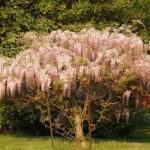Growing a wisteria vine from seeds is a challenging experience for those who have the patience to do it. Cultivating the vine from seeds requires a lot of care and attention and may take up to ten years for the seeds to germinate into a mature vine although the growing span varies depending on the type of wisteria seeds you choose to plant. The youth stage of the plants generally do not bloom until they become adults. However, growing a wisteria vine from seeds can be a rewarding experience if you are successful in doing it, for these hardy vines will bloom year after year once they reach blossoming stage and have a long life span of up to a hundred years.(1) Below are the five best types of wisteria seeds to plants and tips for planting each of them:
The wisteria floribunda, or Japanese wisteria, boasts having the longest raceme, or bunch of flowers from the vine. Think of a raceme like a bunch of grapes only in this case, it is a cluster of flowers. This type of wisteria vine will grow to 35 feet long with beautiful blue or purple flowers. Pink wisteria floribunda also exists but is rare. Before sowing the seeds in a small flowerpot, soak the seeds in warm water one day before planting. You can use potting soil for indoor flowers with some added compost. The seeds should be planted 1/4″ deep and lightly covered with soil. It is important to keep these seeds moist before the germination process. Keep the pot by a sunny window during the day. Partial shade for the seeds is okay if you need to move the pot for any reason. The seeds will germinate between ten to twenty days. Once the wisteria vine starts to grow, fertilize the vine once every several months. Once the vine outgrows the pot, it is ready to plant in the ground outside. Wisteria floribunda will blossom once they reach their mature stage, which is approximately ten years. The green leaves will grow along with the vine.(2) Seeds for this type of wisteria can be purchased from Wisteria Seed.com. One pack of seeds costs $15.00.(3)
Wisteria sinensis, or Chinese wisteria, has white or purple flowers that grow on racemes that are slightly shorter than the Japanese wisteria. This type of wisteria takes a shorter length of time to grow between germination and maturity, seven years at the most. As with the wisteria floribunda, soak the seeds for 24 hours before planting. Sow 1/4″ deep in an indoor pot and cover with soil. The Chinese wisteria seeds are harder to germinate so if nothing appears after twenty days, you can stick the pot in your refrigerator. The cold air will help keep the seeds moist and speed up germination. You can remove the pot from the refrigerator once a week and set in front of the window from sunlight but don’t forget to water the seeds during this period so the heat does not completely dry out the soil. Once the vine germinates and starts to grow, let it develop some roots before moving the vine to a spot outside where it will be planted in the ground.(4) Chinese wisteria can be purchased from Thompson and Morgan(5) for $6.00 for one packet of seeds.
Wisteria brachybotrys, or Shiro Kapitan, has beautiful white racemes that look like bunches of snowy flowers hanging off the vine. This variety of wisteria seeds will also benefit from soaking before being planted indoors in a pot. Plant 1/4″ deep and keep the seeds moist before they germinate. If necessary, stick the pot in the refrigerator as with the Chinese wisteria. Add fertilizer to the young vine to help it grow well. Once the vine is big enough it is ready to be planted outdoors. As with all wisteria vines, this can be trained to grow around trees, light poles, fences, pergolas, or any other sturdy structure nearby.(6) There is also the Okayama type that is also a wisteria brachybotrys but with pink-purple flowers(7) Wisteria brachybotrys will blossom during its first year of maturity. Ask your local nursery about seeds for this wisteria variety, or if you know someone who has a wisteria brachybotrys, ask for some seed pods.
Wisteria macrostachya, or Kentucky wisteria, has lavender flowers that will blossom between two to three years after the vine reaches maturity. This type of wisteria is native to Kentucky thus the name. With the seeds soaked a day before planting, sow into an indoor pot with potting soil with some compost mixed in. Keep these seeds moist before germination begins. This wisteria variety will also benefit from sunlight so set the pot in front of a sunny window in your home. Related to American wisteria, Kentucky wisteria also likes to be fertilized after the young vine starts to grow in its pot and after it is transplanted outside in the ground.(8)
Wisteria venusta, or silky wisteria, has white flowers on its racemes on a vine that grows up to 30 feet long. The drawback with this variety of wisteria is that it may take twenty years from the onset of maturity before it starts to blossom. If you have a green thumb and like a major challenge, though, this is it. Soak the seeds one day beforehand in warm water and plant in your favorite indoor pot. Sow the seeds 1/4″ deep and cover with the soil. Keep the seeds and soil moist and make sure the seeds get adequate sunlight so they can germinate. The seeds will germinate between ten and twenty days. Fertilize the young vines before they get planted outside.(9)
Other tips for growing wisteria:
Add phosphate to the soil once the wisteria vine is planted outside after the last frost. This will help speed up the blossoming period.
Once the mature vines start to grow pods, the seeds from these pods can be dried and saved for another planting, or can be packaged and given to your friends and family.
Any type of wisteria can be trained to grow up any structure, including your house if you have eaves or an outdoor wall trellis.
Prune the wisteria once it starts to blossom to prevent overgrowth. Pruning will also encourage blossoming. Wisteria flowers can also be cut and placed in a vase for the indoors.
Water the mature wisteria vines at least once a week.
1. http://ohioline.osu.edu/hyg-fact/1000/1246.html
2. http://www.rarexoticseeds.com/Bonsai/Graines_Wisteria_Floribunda_Seeds_Japanese
_Wisteria_Seeds_Glycine_Japon.html
3. http://www.wisteriaseed.com/
4. http://www.tsflowers.com/seeds/wisteria.html
5. http://www.thompson-morgan.com/seeds1/group/wisteria.html
6. http://www.mobot.org/gardeninghelp/plantfinder/Plant.asp?code=U730
7. http://www.wisteria.it/brachoka-e.htm
8. http://www.cirrusimage.com/tree_wisteria.htm
9. http://www.ces.ncsu.edu/depts/hort/consumer/factsheets/vines/wisteria_venusta.html




